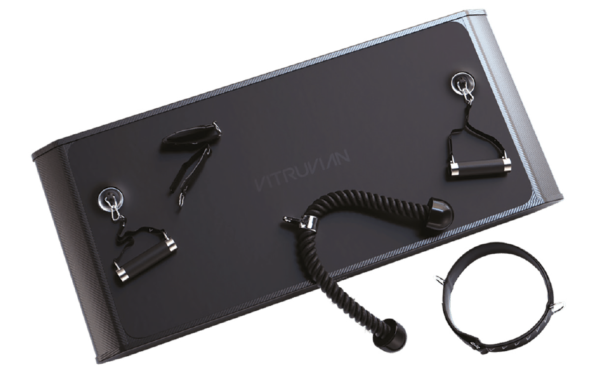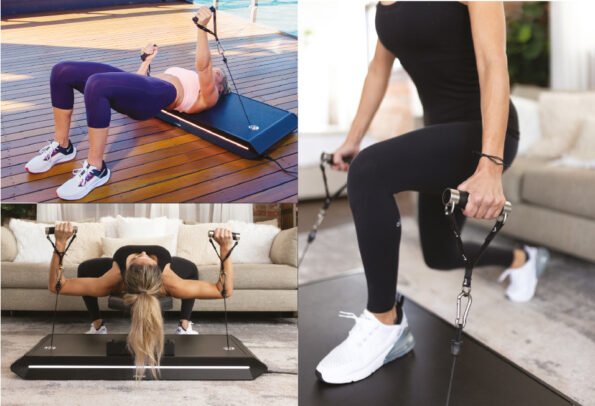MAXIM Gains Guru, Alexa, takes a look at one of the biggest debates in resistance training – free weights versus machines. Which is superior/inferior or are they equal?…
Earlier in my career, I believed that machines were “obviously” the lesser choice. I’d argue that they only required you to overcome resistance, not control it. I believed that machines were “too stable” and that people who used them lacked the intestinal fortitude to learn how to use free weights correctly. As a Team Free Weights advocate, I stood behind Paul Chek’s quote: “Machines are like sleeping pills for the nervous system”. Thankfully, both myself AND technology have evolved, and if you asked me what the best way to get big and strong is now, you’ll get the much more open and objective answer, “That depends.”
WHAT YOU NEED TO KNOW
Current science suggests that muscles get bigger and stronger when they’re exposed to unaccustomed levels of tension. The magnitude of that tension is most important for strength goals, and the volume of that tension — the number of times your muscles experience tension per unit of time — is what matters most for size. The BEST exercises are the ones that allow you to safely expose your muscles to external tensions that are sufficient enough to trigger adaptation.
MACHINE TRAINING FOR INJURY CIRCUMVENTION
There are many situations where injuries may permit machine training but NOT free weight training. Wrist and hand injuries permit leg pressing or Smith Machine Squats when barbell squatting wouldn’t be possible. Elbow issues often permit cable crossovers or pec dec when barbell and dumbbell pressing isn’t an option. And lower back issues will usually allow for leg extensions and leg curls when Bent Over Rows, Squats or Deadlifts are a no-go. Whatever your stance on machines versus free weights, I think we’d all agree that machine training is certainly superior to no training at all.
DOUBLING UP
The truth is both machines AND free weights expose your body to tension, and they are BOTH good options — with their own pros and cons — depending on your specific goals, training experience and structural limitations. Sometimes machines are the better option, sometimes free weights are. And with the rise of the “Smart Training Platform” such as the Vitruvian Trainer+, you can now merge the individual benefits together and get the best of both worlds – for more about this epic device, see page 24. For those of you who like to keep your options open, the intelligent use of both machines and free weights can offer greater benefits than restricting yourself to one or the other.

MACHINE + FREE WEIGHTS PROGRAMMING – IN THE GYM
One of the most effective ways to combine the two modalities would be to use Agonist Supersets. Essentially this is the pairing of two exercises that target the same muscle, and it tends to work best as a combination of a compound movement with an isolation movement. Pairing two compound movements could be too intense in the same way that pairing two isolation movements could lack intensity. There are two main ways you could do this:
- Pre-exhaustion Supersets:
This method allows you to exhaust a muscle group by performing an isolation exercise BEFORE your compound lift. Check your ego at the door and start out with a lighter weight than you normally would when using this method because your muscles will already be tired by the time you get to your big lift.
Here are some examples of how a pre-exhaustion protocol can be applied to lower body training:
A1. Seated Leg Extension: 15 reps, 2011 tempo, rest 10 seconds
A2. Weighted Squats: 8-10 reps, 4010 tempo, rest 60 secs. 3-4 rounds
B1. Lying Hamstring Curls: 15 reps, 3010 tempo, rest 10 seconds
B2. Weighted RDL: 8-10 reps, 3011 tempo, rest 60 secs. 3-4 rounds
- Post-exhaustion Supersets:
This method of super-setting takes pain to a whole new level. You perform a compound lift first and then add an isolation exercise immediately after that to completely trash all the muscle fibres in a certain muscle group. Finish off with leg extensions to failure after your squats and you’ll soon understand the need to keep reminding yourself that “Discomfort equals Growth.”
Here are some examples of how a post-exhaustion protocol can be applied to upper body training:
A1. Weighted Bench Press/Dip: 4-6 reps, 3210 tempo, rest 10 seconds
A2. Overhead Tricep Cable/Rope Extensions: 4 x 12-15 reps, 3110 tempo, rest 2 minutes. 4 rounds
B1. Chin Ups: 4-6 reps, 4010 tempo, rest 10 secs
B2. Cable/Rope Bicep Curls: 10-12 reps, 5010 tempo, rest 2 minutes. 4 rounds
C1. Military Press: 4-6 reps, 3111, rest 10 secs
C2. Cable Lateral Raise: 12-15 reps, 2020, rest 2 minutes. 4 rounds
D1. Cabled Bent Over Row: 4-6 reps, 4010 tempo, rest 10 seconds
D2. Seated Row: 10-12 reps, 3022 tempo, 2 mins rest. 4 rounds
TOP TIP:
You can also use isolation exercises before bigger lifts to pre-stimulate the target muscle – improving your mind-muscle connection and muscle fiber recruitment – allowing you to really “feel” what you’re working on. Think DB/Cable Flyes before you bench or back extensions before you hip thrust.
MACHINE TRAINING WHEN TIME IS A FACTOR
When considering exercise selection, take into account both the costs and the benefits. Machines take considerably less time to set up, warm up and change weights between sets. If you’re on a tight schedule, a machine might allow you to train a muscle faster and with less psychic stress. And for those of you wanting to continue to train at home, the Vitruvian Trainer+ is the perfect ONE STOP SHOP solution and allows you to perform both compound and isolation exercises on the one machine. Turn the page for more!
THE UTIMATE HOME TRAINER
MACHINE + FREE WEIGHT PROGRAMMING – AT HOME
The most effective way to combine ALL the benefits of machine work with ALL the benefits of free weight training, ALL in the comfort of your own home — would be to invest in the sleek and clever little piece of equipment that is the VITRUVIAN TRAINER+. Essentially, you’d have access to cables, a rope, and all the DB and KB weight options you could ever need. Even better, you would have none of the space requirements or mess that often goes hand in hand with a home gym set up. The cutting edge hardware and software combination provides a full range of resistance based training that you can complete in your home while being connected to a whole community of like-minded individuals.
If your goal is to achieve maximum hypertrophy and place your muscles under as much tension as possible throughout the entire range of motion on an exercise, then cables could be your missing link. Not only do they offer multiple lines of resistance in different planes of movement, but they also limit the amount of momentum that you can produce — you can’t cheat the movement BUT you can perform faster reps with minimal loss of tension which is great for metabolic conditioning.

VITRUVIAN ACTION
Here’s a few of my favourite bang-for-your-buck exercises you can perform on the Vitruvian Trainer+ using the cables, as you would a barbell, alongside their more functional and isolation-based counterparts – i.e. using the cables in place of dumbbells or kettlebells. Check out the following compound movements:
- BENCH PRESS
Functional: Top Down Alternating Bench Press (keep one arm locked out at the top of the movement while the other arm moves).
Isolation: Flat Bench Cable Flyes.
- DEADLIFT
Functional: Staggered Stance Deadlift (the back toe is in line with the front heel allowing you to focus on structural balance between sides).
Isolation: Single Leg Hamstring Bridge. Lie on your back with your heel on the platform, raise your hips and hold your pelvis level.
TOP TIP:
If your lower back is the limiting factor in deadlifts when the cables are in front of you, you can set up with the handles beside you as you would with a Trap Bar or DB’s/KB’s in the gym.

- Neutral Grip Bent Over Row (or Seated Row)
Functional: Top Down Alternating Row (one arm remains in the row position while the other arm moves).
Isolation: Bent Over Reverse Flyes.
TOP TIP:
For any desk jockeys who struggle to keep their shoulders from rolling forwards in an overhand grip on a cable, being able to utilise handles for a neutral grip (palms facing each other) can be a really useful option.
- FRONT LOADED SQUAT (holding both handles up by the shoulders)
Functional: Front Loaded Squat Single Arm Squat (the offset in load forces the core to work harder to stabilise).
Isolation: Cyclist Squats. Elevate your heels on the platform and think about sliding your back down a wall taking your knees over your toes.
TOP TIP:
If you have any shoulder issues, the handles allow you to work in neutral grip (palms facing in), which is the safest position from which to work from.
- OVERHEAD PRESS
Functional: Tall Kneeling Single Arm Press.
Isolation: Cable Lateral Raises.
TOP TIP:
Don’t forget your calves — what better use of an elevated platform than to encourage full range of motion through your feet, ankles and Achilles.
One machine. ALL the workouts. For more info go to vitruvianform.com
By ALEXA TOWERSEY
For the full article grab the February 2022 issue of MAXIM Australia from newsagents and convenience locations. Subscribe here.




